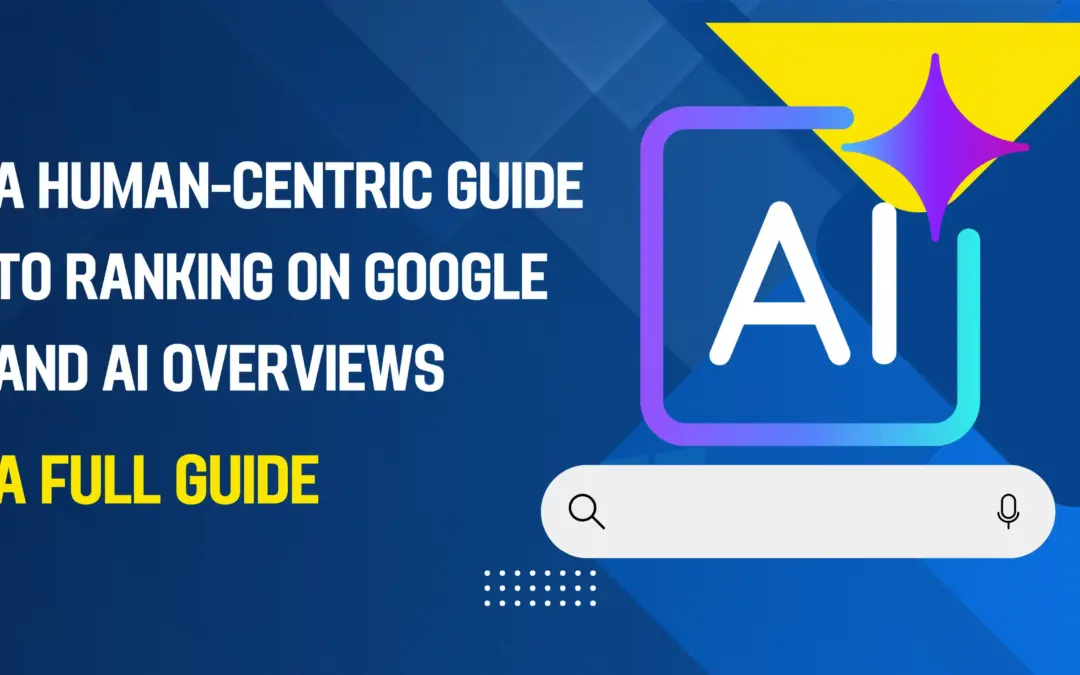How to Be the Answer: A Guide to Ranking on Google and AI Overviews
Feeling like your great content is getting lost in the sea of search results? You’re not alone. With the rise of AI Overviews (Google’s new generative search experience), the game is changing. But don’t see it as a threat, see it as your biggest opportunity yet.
The secret isn’t to outsmart the algorithm; it’s to do what you do best: connect with people. Google’s AI is simply learning to recognize that human connection better than ever before. This guide will show you how to create content that both people and AI love.
1. Shift Your Mindset: From “Ranking” to “Being the Source”
The old goal was to be the #1 blue link. The new goal is to be the trusted source that the AI cites to build its answer.
- Think of the AI as a Brilliant Research Assistant: It’s scouring the web to write the perfect answer for its boss (the user). Your job is to create content so good, so reliable, and so clear that the research assistant has to use it.
- You’re Not Writing for Bots; You’re Writing for People Through a Bot: The AI is trained on what humans find helpful. If humans love your content, the AI will too.
Example: Instead of just trying to rank for “best running shoes for flat feet,” aim to create the ultimate guide that a podiatrist would recommend. That’s the level of depth we’re talking about.
2. Become the Authority: Unleash Your E-E-A-T
Experience, Expertise, Authoritativeness, and Trustworthiness (E-E-A-T) are your new best friends. This is the cornerstone of ranking in the AI era.
- Show Your Work: Don’t just state facts. Explain why they are true. Cite studies, link to reputable sources, and include data.
- Showcase Your Credentials: Do you have 10 years of experience as a gardener? Say so! Have you tested every single blender you review? Create a “testing methodology” section. This builds immense trust.
- Humanize Your Content: Use a real author byline with a photo and bio. Let your personality and unique experience shine through.
Human Touch Example:
Instead of: “Philodendrons need well-draining soil.”
Write: “In my five years of running a plant nursery, I’ve seen more philodendrons succumb to root rot than anything else. That’s why I always mix my potting soil with extra perlite—it makes all the difference. Here’s a photo of my own mix so you can see what I mean.”
3. Answer the Question, Then Answer the Next One
AI Overviews are designed to satisfy user intent completely. Your content should do the same.
- Target Question-Based Keywords: Use tools like AnswerThePublic or AlsoAsked.com to find real questions people ask.
- Primary Keyword: “How to make sourdough starter”
- Related Questions: “Why did my sourdough starter fail?”, “How do I know if my starter is active?”, “What can I do with sourdough discard?”
- Create Content Hubs: Build a pillar page that comprehensively covers a topic, then link to cluster pages that answer specific subtopics. This tells Google you are a definitive resource on the subject.
Example:
A recipe for sourdough bread should be more than just a list of ingredients. It should include:
- The “Why”: “Letting the dough autolyse for 30 minutes allows the flour to fully hydrate, leading to a less sticky dough and a better crumb—trust me, it’s worth the wait!”
- Troubleshooting: “If your dough isn’t doubling in size, your kitchen might be too cold. Try placing it in the oven with the light on for a cozy, draft-proof spot.”
- The Next Step: “What to do with your leftover sourdough discard? Here are my 3 favorite recipes.”
4. Structure for Scanners (Human and AI)
Both busy readers and AI models scan content to understand its structure and find answers quickly.
- Use Descriptive Headers: Clear H2 and H3 tags act as a table of contents.
- Weak Header: “The Process”
- Strong Header: “Step 3: How to Knead Your Sourdough Dough Properly”
- Use Bullet Points and Numbered Lists: They are incredibly easy to extract information from.
- Add a FAQ Section: Use a natural, conversational tone. This is prime real estate for capturing AI Overview snippets.
Human Touch Example:
Q: I’m impatient! Can I speed up the rising process?
A: I feel you! I’ve tried putting it near a heater, but that often dries out the dough. The best way is to use a slightly warmer water temperature when you start, around 85°F (30°C). But remember, slow fermentation develops the best flavor.
5. Speak Google’s Language with Schema Markup.
Schema is like giving Google a guided tour of your content. It removes all guesswork.
- What to Use: For most content, HowTo, FAQPage, Article, and Recipe schemas are incredibly powerful.
- How it Helps: It directly tells the AI, “This section is a step-by-step guide,” and “This is a question and answer.” This makes your content incredibly easy to pull into an AI Overview.
Example: If you have a recipe, the Recipe schema can tell Google the cook time, calories, and rating. That specific data can be pulled directly into the answer.
The Heart of It All: Be Uniquely Helpful.
The ultimate strategy is to create content that only you can make.
- Do Original Testing: “We tested 5 popular stain removers on red wine. Here are the real, unedited results with photos.”
- Share a Personal Story: “How I Paid Off $50K of Debt in 2 Years While Working a Minimum Wage Job.” Your unique experience is your superpower.
- Synthesize Complex Topics: Break down a complicated subject (e.g., “How does a mortgage work?”) into simple, relatable language with analogies. “Think of your down payment like a security deposit on an apartment…”
By focusing on the human behind the search query, you naturally create the kind of trustworthy, comprehensive, and structured content that Google’s AI Overviews are built upon. Stop playing the algorithm game. Start playing the helpfulness game. The rankings will follow.

